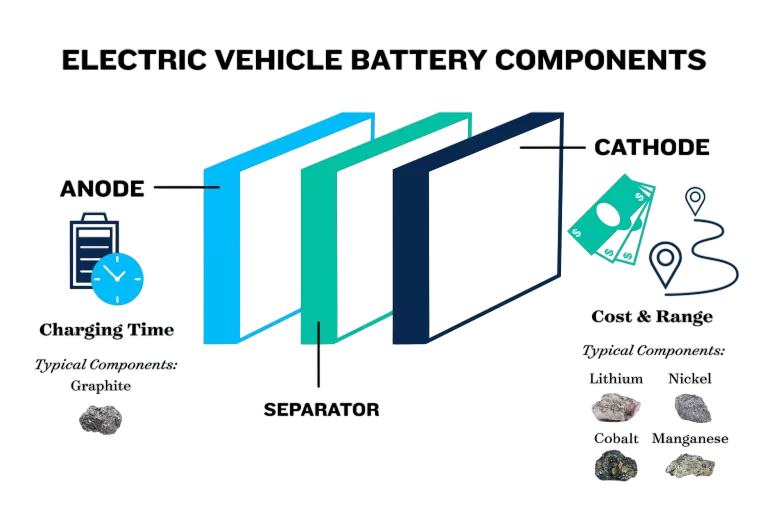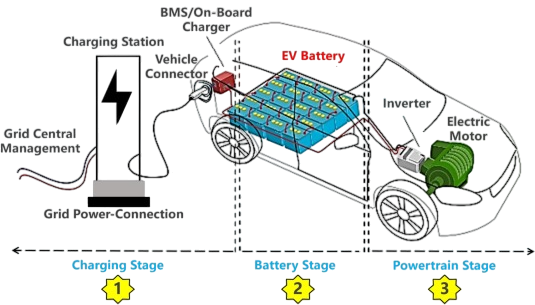
- The Heart of the Electric Revolution
- What is an Electric Vehicle Battery?
- The Key Components of an EV Battery
- How Does an EV Battery Store and Release Energy?
- Benefits of Electric Vehicle Battery Technology
- Understanding EV Battery Lifespan and Degradation
- The Future of EV Battery Technology
- Battery Recycling and Sustainability
- Conclusion
The Heart of the Electric Revolution
The electric vehicle (EV) is no longer just a niche product. It is at the forefront of a transportation revolution. At the center of every electric vehicle is a crucial element: the electric vehicle battery. To explore how intelligent systems optimize battery performance through predictive diagnostics, smart energy distribution, and adaptive thermal management, explore Artificial Intelligence Training a hands-on course that covers machine learning, embedded AI, and advanced energy solutions for next-generation electric vehicles. This essential component stores energy that allows for emission-free travel. Understanding how your EV battery operates, what it consists of, and how to maintain it is important for every electric car owner or enthusiast. This guide will delve into the world of the EV battery, simplifying its technology and highlighting its role in promoting sustainable transportation.
What is an Electric Vehicle Battery?
An electric vehicle battery, commonly called an EV battery, is a rechargeable battery pack that powers the electric motor in an electric car. Beyond simply storing energy, modern EV batteries incorporate advanced thermal management, safety monitoring, and fast-charging capabilities to ensure performance and longevity. To explore the science, innovations, and future trends behind these energy systems, explore EV Battery Technology a comprehensive guide that explains battery chemistries, charging cycles, energy density improvements, recycling methods, and the breakthroughs shaping next-generation electric mobility. Unlike small batteries in devices like remote controls, EV batteries are large and complex systems. They hold a considerable amount of electrical energy, which converts into mechanical energy to turn the wheels. You can think of it as the fuel tank for your electric vehicle; it contains electricity instead of gasoline.
Ready to Get Certified in Artificial Intelligence ? Explore the Program Now Artificial Intelligence Online Training Offered By ACTE Right Now!
The Key Components of an EV Battery
Modern electric vehicle batteries mainly use lithium-ion (Li-ion) technology. This is the same type of battery found in smartphones and laptops, although at a much larger scale. A typical Li-ion EV battery pack consists of thousands of individual cells. These cells are grouped into modules, and several modules make up the complete battery pack. To understand how these battery systems integrate with motors, controllers, and charging infrastructure, explore Electric Vehicle Technology a comprehensive guide that explains EV architecture, battery innovations, motor types, powertrain systems, and the engineering breakthroughs driving the future of electric mobility.
- Cathode: This is where lithium ions are stored when the battery is discharged. Common cathode materials include nickel, manganese, and cobalt (NMC) or lithium iron phosphate (LFP).
- Anode: Usually made of graphite, this is where lithium ions are stored when the battery is charged.
- Electrolyte: This can be liquid or gel, allowing lithium ions to move between the cathode and anode.
- Separator: A thin barrier that keeps the cathode and anode from touching, which would cause a short circuit.
- Charging: When you plug in your electric vehicle, electricity flows into the battery. This electrical energy pushes lithium ions to move from the cathode, through the electrolyte and separator, to the anode, where they are stored.
- Discharging: When you drive your electric car, the process reverses. The lithium ions move back from the anode, through the electrolyte and separator, to the cathode. This movement generates an electrical current that powers the electric motor.
- Lifespan: Most EV batteries are made to last many years and hundreds of thousands of miles. Manufacturers often provide warranties that cover the battery for 8 years or 100,000 miles, whichever comes first.
- Degradation Factors: Battery degradation is affected by factors such as charging habits, climate, and the number of charge cycles. Frequent fast charging and exposure to extreme temperatures can speed up degradation.
- Battery Management Systems (BMS): EVs come with advanced BMS that monitor and manage the battery’s health. They help optimize charging, discharging, and thermal control, extending the battery’s life.
- Level 1 Charging: This method uses a standard household outlet and is the slowest charging option. It’s suitable for overnight charging but can be too slow for quick top-ups.
- Level 2 Charging: This approach uses a 240-volt outlet and is commonly found in homes and public charging stations. It offers significantly faster charging speeds than Level 1.
- DC Fast Charging (Level 3): These are the quickest chargers, located at public charging networks. They can add considerable range in a short time, but frequent use may affect battery health more than slower charging methods.
- Second Life Applications: Before being recycled, EV batteries can be repurposed for “second life” uses, like energy storage for homes or businesses.
- Recycling Processes: Advanced recycling methods are extracting valuable materials such as lithium, cobalt, and nickel from used EV batteries. This lessens the need for mining new raw materials and supports a circular economy.
- Government and Industry Initiatives: Many organizations are investing in building effective and sustainable battery recycling systems.

To Explore Artificial Intelligence in Depth, Check Out Our Comprehensive Artificial Intelligence Online Training To Gain Insights From Our Experts!
How Does an EV Battery Store and Release Energy?
The charging and discharging of an EV battery involves a fascinating chemical reaction. To explore how intelligent systems optimize these electrochemical processes through predictive diagnostics, smart energy distribution, and adaptive thermal management, explore Artificial Intelligence Training a hands-on course that covers machine learning, embedded AI, and advanced energy solutions for next-generation electric vehicles.
Benefits of Electric Vehicle Battery Technology
Advancements in electric vehicle (EV) battery technology have resulted in numerous benefits for drivers and the environment. One major advantage is the elimination of tailpipe emissions; electric vehicles do not produce harmful exhaust fumes. This improves air quality in cities and reduces overall carbon footprints. The financial aspect of owning an EV is also attractive, with lower running costs, reduced maintenance expenses, and government incentives making them more accessible. To explore the broader benefits, models, and innovations driving sustainable mobility, explore Electric Vehicles a comprehensive guide that explains EV adoption, environmental impact, charging infrastructure, battery systems, and the engineering breakthroughs shaping the future of transportation. Electricity typically costs less per mile than gasoline, and electric vehicles have fewer moving parts, which lowers maintenance costs. Additionally, drivers benefit from a quieter and smoother ride. Electric motors generate less noise than gasoline engines, providing a more peaceful driving experience. The performance of electric vehicles is impressive as well. The batteries deliver instant torque, allowing for quick acceleration and a responsive driving feel. This enhances overall comfort and enjoyment on the road. Ultimately, these advancements in EV battery technology support a cleaner environment and improve the driving experience, making electric vehicles a more appealing choice for consumers.
Understanding EV Battery Lifespan and Degradation
Like all batteries, EV batteries will degrade over time, which means their maximum capacity will gradually decline. However, electric vehicle battery technology has improved significantly, and modern EV batteries are designed to last with enhanced durability, faster charging, and better thermal management. To explore how battery longevity challenges are addressed through innovative replacement models, explore Battery Swapping EV Technology a comprehensive guide that explains swapping infrastructure, operational efficiency, cost benefits, and how this approach is revolutionizing EV adoption worldwide.
Looking to Master Machine Learning? Discover the Artificial Intelligence Expert Masters Program Training Course Available at ACTE Now!
The Future of EV Battery Technology
Innovation in electric vehicle (EV) battery technology is advancing rapidly, fueled by researchers determined to create next-generation batteries that offer better performance, lower costs, and increased sustainability. As these advancements unfold, the importance of accessible and reliable charging infrastructure grows alongside them. To explore how charging hubs are being deployed and optimized across India, explore EV Charging Stations a comprehensive guide that explains station types, connector standards, installation practices, and the role of charging networks in supporting large-scale EV adoption.

One promising development in this field is the rise of solid-state batteries, which replace the traditional liquid electrolyte with a solid material. This change holds the potential for higher energy density, faster charging, and improved safety features, making them an exciting option for the future of EVs. Additionally, researchers are working on enhancing lithium-ion chemistries by reducing or even eliminating cobalt, a material that raises ethical sourcing concerns and is often expensive. Instead, there is growing interest in using more readily available materials like sodium, which could greatly cut production costs. Moreover, efforts are being made to reduce charging times, aiming to make EV ownership even more convenient and accessible for consumers. As innovations in EV battery technology continue to progress, they promise to reshape electric transportation, improving the overall user experience while supporting sustainable practices.
Preparing for Artificial Intelligence Job Interviews? Have a Look at Our Blog on Artificial Intelligence Interview Questions and Answers To Ace Your Interview!
Battery Recycling and Sustainability
How you charge your electric vehicle impacts its battery health. Charging speed, frequency, and temperature conditions all influence the long-term performance of the battery pack. Embedded systems play a critical role here, as they monitor charging cycles, regulate voltage, and ensure safety protocols are followed during every charge. To understand how these intelligent systems optimize charging and overall vehicle performance, explore Embedded Systems in Electric Vehicle a comprehensive guide that explains microcontroller functions, sensor integration, real-time monitoring, and the advanced algorithms that make EVs smarter and more efficient.
It’s generally recommended to use a mix of charging methods, favoring Level 2 charging for daily use and saving DC fast charging for longer trips. The environmental impact of EV batteries is an important consideration. As more EVs are on the road, responsible battery recycling becomes crucial.
Conclusion
The electric vehicle battery is essential to the electric vehicle revolution. Its progress has made EVs a practical and appealing alternative to traditional gasoline cars. With their complex lithium-ion chemistry, long lifespan, and continuous improvements in battery technology, EV batteries play a critical role in creating a cleaner and more sustainable transportation future. To explore how intelligent systems advance battery innovation through predictive diagnostics, smart energy distribution, and adaptive thermal management, explore Artificial Intelligence Training a hands-on course that covers machine learning, embedded AI, and advanced energy solutions for next-generation electric vehicles. As technology advancements continue, we can expect longer ranges, faster charging, and lower electric vehicle prices. This will make it easier for everyone to transition to electricity. Understanding your EV battery is the first step toward embracing this exciting future.




